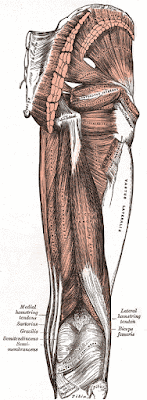
Paschimottanasana (Hamstring Challenged!)
Q: A friend of mine recently completed a yoga teacher training. She was told to not lift the butt cheeks back (move them out of the way) in Paschimottanasana (seated straight leg forward bend) because it might strain a tendon when you do the forward fold. I have always lifted my butt cheeks back, because as you know (despite now 21+ years of yoga) I am “hamstring challenged.” Your thoughts on this? Thanks!A: Thank you for this clarification question on how to approach this specific pose. To restate the question/warning: we have a new graduate of yoga teacher training that has learned that when doing the seated forward bend Paschimottanasana, you should not reach under your buttocks flesh and pull it backwards due to the risk of straining a tendon while folding into the pose. And my experienced opinion is—that it depends!
Before I get to what it depends upon exactly, I would like to share some personal perspective on this fairly typical instruction for Paschimottanasana. I started off my yoga class experience attending a lot a classes in the Iyengar tradition. In that tradition (and in many others, I suspect), this adjustment to your pelvis was almost always used right before you started bending forward. The rationale seemed to go something like this: in seated forward bends, unlike standing ones, the pelvis/buttock flesh/sit bones are “stuck” somewhat on the floor by friction and gravity, and not as free to rotate forward (the action of forward rolling of the pelvis over the head of the thigh bones) into the pose. So, by lifting the buttock flesh and pulling it back on each side, you are encouraging some of that anteversion of the pelvis that allows you to fold forward more deeply. In an otherwise healthy individual, this could allow more overall forward fold of the pelvis and torso, and would not significantly increase the likelihood of injuring a tendon.
What tendon is our mystery teacher referring to? Well, in all likelihood it is the origin of the Hamstring tendon at the sitting bones right and left.

Another factor to consider is what the underlying benefits and purpose of this seated forward bend are. According to Light on Yoga, Mr. Iyengar claims the pose, “tones the abdominal organs and keeps them free from sluggishness. It also tones the kidneys, rejuvenates the whole spine and improves the digestion.” Wow! And he goes on to list a whole bunch of other benefits as well. It is hard to know how much of this is actually true, as no one has done an isolated study on just this pose to confirm these assertions, so take them with a large grain of salt. One other purported benefit of Paschimottanasana and variations of it, such as Janusirsana, is that this group of poses is quieting to the mind and emotions. Again, not a lot of formal study to prove this, and if you are like me and have very tight hamstrings, being encouraged to go deeper into the forward fold has the opposite effect on my mind and emotions. So, the way one enters and maintains the pose is going to support or conflict with this possible benefit of Paschimottanasana.
But from a more purely musculoskeletal perspective, taking the forward fold to your own personal edge of feeling resistance to going further could have the following benefits:
- improve forward anteversion of the pelvis
- lengthen the hamstrings as well as the posterior muscles of the spine
- bring some compression to the front hip joints and abdominal area
So how does that translate into the warning we are discussing today? If a practitioner does not have a previous strain to the hamstring tendon, then making the buttocks adjustment can reasonably be tried. From that point forward, the key to keeping the hamstrings stretching safely as you mindfully fold forward is to monitor the sensation feedback you are getting from the leg muscles to your brain. If pain arises, back off a bit, even if you have only pivoted forward 10 degrees. That might be your ideal spot to work today. And I never have students pull with the hands and arms on the feet or legs to “go deeper” into the forward bend. That is a potential recipe for hamstring disaster! So, use your hands to stabilize your torso, but don’t pull. Finally, fold forward in a way that does create some sensation of stretch and compression in the areas mentioned above, while also allowing your breath to stay relaxed and, body willing, your mind and emotions to remain calm. Then, watch the benefits accrue.
—Baxter
Subscribe to Yoga for Healthy Aging by Email ° Follow Yoga for Healthy Aging on Facebook ° Join this site with Google Friend Connect

